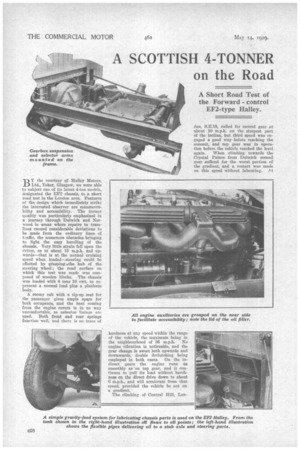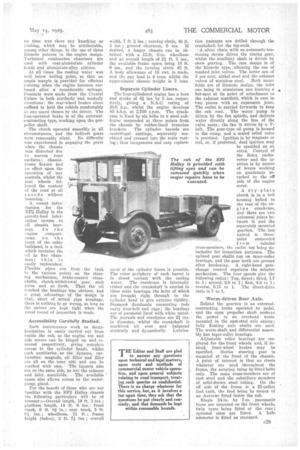A SCOTTISH 4-TONNER on the Road
Page 58

Page 59

If you've noticed an error in this article please click here to report it so we can fix it.
BYthe courtesy of Halley Motors, Ltd., Yoker, Glasgow, we were able to subject one of its latest 4-ton models, designated the EF2 chassis, to a short road test in the London area. Features of the design which immediately strike the interested observer are manmuvrability and accessibility. The former quality was particularly emphasized in a journey through Dulwich and Norwood in areas where repairs to tramlines caused considerable deviations to be made from the ordinary lines of traffic, the numerous obstacles bringing to light the easy handling of the chassis. Very little strain fell upon the driver, as at about 15 m.p.h. and Upwards—that is at the normal cruising speed when loaded—steering could be effected by grasping .the hub of the steering wheel; the road surface on which this test was made was composed of wooden blocks. The chassis was loaded with 4 tons 10 cwt. to represent a normal load plus a platform body.
A roomy cab with a tip-up seat for the passenger gives ample space for both occupants, and the heat coming from the engine covers is in no way uncomfortable, as asbestos linings are used. Both front and rear springs function well, and there is 110 trace of hardness at any speed within the range of the vehicle, the maximum being in the neighbourhood of 36 m.p.h. No engine vibration is noticeable, and the gear change is sweet both upwards and downwards, double declutching being employed in both cases. On the indirect gears the engine runs as smoothly as on top gear, and it continues to pnll its load without harshness on the direct drive down to about 6 m.p.h., and will accelerate from that speed, provided the vehicle be not on a gradient.
The climbing of Central Hill, Lon
no time was there any knocking or teinkiug, which may be attributable, among other things, to the use of three Ricardo patents in the engine design. Turbulent, combustion 'chambers are used with cast-aluminium cylinder heads and aluminium-alloy pistons.
At all times the cooling water was well below boiling point, so that an ample margin is provided for efficient running when the engine becomes carboned after a considerable mileage. Descents were made from the Crystal Palace in both northerly and westerly directions ; the rear-Wheel brakes alone sufficed to hold the vehicle comfortably at any speed chosen by the driver.. The foot-operated brake is of the externalcontracting type, working upon the propeller shaft.
The clutch operated smoothly in all circumstances, and the indireet gears
were reasonably silent. No difficulty was experienced in engaging the gears when the chassis was distorted due to uneven road eurfaCes; chassisframe flexure had no effect upon the operation of any controls, whilst the rear wheels followed the contour of the road at all speeds without bouncing.
A recent introduction -for the EF2 Halley is the gravity-feed lubrication system to all chassis bearings. In the engine compartment, on the front of the cabin bulkhead, is a tank which contains the oil in five chanthers; this is easily replenished.
Flexible pipes run from. the tank to the various points , on the steering mechanism, brake-control crossshafts, clutch-withdrawal gear, stub axles and so forth. That the oil reached the bearings was obvious, and a great advantage of the design is that, short of actual pipe breakage, there is nothing to go wroug, so long as the unions arc kept tight when the usual round of inspection is made.
Accessibility Carefully Studied.
Such maintenance work as decarbouization is easily carried out from inside the cab, as the engine top and side covers can be hinged up and removed respectively, giving complete access -to the cylinder heads, whilst such auxiliaries, as the dynamo, carburetter, magneto, oil filter and filler are all on the near side and can be reached with case. The tappets also are-on thesame side, as are the exhaust
and inlet manifolds. The available space also allows access to the waterpump gland.
For the benefit of those who are not familiar with the E2 Halley. chassis the following particulars will be of inlereet :—Overall length, 19 ft. 8 ins. ; Platform length, 14 ft. 6 ins.; front track, 6 ft Oi in.; rear track, 5 ft. telins.; wheelbase, 11 ft. ; frame height (laden), 2 ft. 71 ins.; overall width, 7 ft. 2 ins.; turning-circle, 40 ft.
3 ins. ; ground clearance, 9 ins. If desired, a longer chassis can be obtained with a 12-ft. 6-in, wheelbase and an overall length of 21 ft. '3 ins., the available frame space being 16 ft. 6 ins,, and the turning circle 45 ft. A body allowance of 10 cwt. is made, and the pay load is 4 tons, whilst the epproxitnate chassis weight is 3 tons.
Separate Cylinder Liners.
The four-cylindered engine has a boreand stroke of 4 ins. by 5 ins, respectively, giving a R.A.C. rating of 30.6 h.p., whilst the engine develops 85 b.h.p. at 2,700 r.p.m. The crankcase is fixed by six bolts to a steel subframe suspended at three points from the chassis by rubber-lined trunnion brackets. The cylinder barrels are centrifugal castings, separately machined and pressed into the main casting; thus inexpensive and easy replace, taunt of the cylinder liners is possible. The outer periphery of each. barrel is in direct contact with the cooling water. The crankcase is internally ribbed and the crankshaft is carried in three main bearings, the bolts of which are brought right through to the cylinder head to give extreme rigidity. Stampe4 duralumin connecting rods carry four-bolt end caps ; the bearings are of gunmetal lined with white metal. The journals and crankpins are 2-I ins. in diameter, whilst the crankshaft is machined all over and balanced statically and dynamically. Lubriea
tion passages are drilled through the crankshaft for the big-ends.
-A silent chain with an automatic tensioning device drives the timing gear, whilst the auxiliary shaft is driven by skew gearing. The cam design is of the Ricardo type, allowing the use of masked inlet valves. The latter are of 3-per cent, nickel steel and the exhaust valves of stainless steel. Both rnani-folds are of Ricardo design, the inlet one being in aluminium and forming a hot-spot at its point of attachment to the exhaust manifold, which is cast in two pieces with an expansion joint. The outlet is carried forwards to keep the cab cool. The water pump is driven by the fan spindle, and delivers water directly along the line of the valve seats ; the fan is driven by a Vbelt. The gear-type oil pump is housed in the sump, and a sealed relief valve is provided. Ignition is by magneto or coil, or, if preferred, dual ignition may be specified as an extra. Control of the Solex carburetter and the ignition is by means of levers working on quadrants attached to the off side of the engine cover.
A dry-plate clutch is in a bell housing bolted to the rear Of the engine crankcase, and there are two universal joints between it and the separately mounted gearbox. The last named is threepoint suspended from tubular cross-members, the entire top being detachable for inspection purposes. The epllned gear shafts run on taner-roller bearings, and the gear teeth are ground after hardening. 'A right-hand gatechange control regulates the selector mechanism. The four speeds give the following ratios: Top, direct; third, 1.7 to 1 ; second, 2.8 to 1; first, 4.8 to 1; reverse, 6.15 to 1. The direct-drive ratio is 7 to 1. The cab of the EF2 Halley is provided with lifting eyes and canbe removed quickly when major repairs have to be executed.
Worm-driven Rear Axle.
Behind the gearbox is an external. contracting brake operated by pedal, and the open propeller shaft coreveys the power to an overhead worm mounted in the east-steel axle easing ; fully floating axle shafts are used. The worm-shaft and differential aasem• bly has taper-roller bearings.
Adjustable roller bearings are employed for the front wheels: and, if desired, front-wheel brakes may be specified. Merles steering gear is mounted at the front of the chassis. A point of interest is that no rivets whatever are used throughout the frame, the securing being by fitted bolts only. The main' cross-members are of cast steel and the subsidiary members of solid-drawn steel tubing. On the off side of the frame is a 25-gallon fuel tank, the feed being by means of an Antovae fitted inside the cab.
Single 34-in. by 7-in, pneumatic
tyres are mounted on the front wheels, twin tyres being fitted at the rear; optional sizes are listed. A hubodometer is fitted as standard.




























































































































